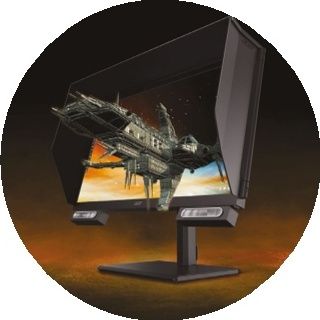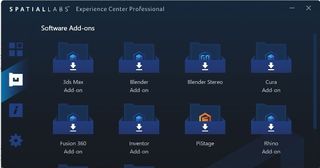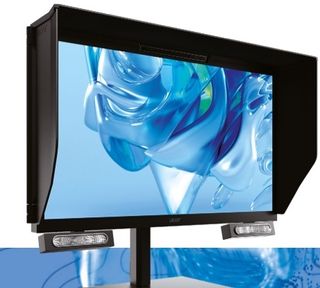
This review first appeared in issue 358 of PC Pro.
Hot on the heels of the Lenovo ThinkVision 27 3D I reviewed last month comes Acer’s spin on the same concept. Both are 27in 4K monitors that can jump between 2D and 3D modes, allowing developers to view creations on demand. No need for special glasses or VR goggles; just render and go.
It’s a marriage of hardware and software, and I’ll tackle the hardware first. One pivotal inclusion is a pair of eye-tracking cameras; here, they sit in the top bezel rather than the bottom (Lenovo’s choice), and they work equally well. The second hardware component is a 3D lens that sits above the panel and projects pixels to the left and right eyes as needed. A 3D engine built into the monitor’s electronics takes control of what’s beamed where.
While Lenovo includes a fine pair of speakers in the ThinkVision, they’re nothing compared to the duo beneath the main body of the SpatialLabs 27 View Pro. These provide superb stereo separation in normal use, but their skills come to the fore when you activate Acer’s aptly named Immerse Audio app. This plants you straight into the action, with the only missing direction being from behind you.

The 3D experience
Acer supplies an app called SpatialLabs Experience Center Professional with this monitor, and it’s your direct route to activating 3D effects. The main menu offers you three options: SpatialLabs Go, SpatialLabs Model Viewer and SpatialLabs Player.
SpatialLabs Player is the simplest, as its role is simply to let you turn side-by-side videos into stereoscopic 3D. A YouTube search will bring up a bunch of example videos that have been shot at two angles – one for the left eye, one for the right – and you’ll be impressed by the effects, if not the plotlines. Most of the best videos are ads.
With few movies created in 3D, SpatialLabs Go is there to turn 2D content into 3D in real-time.
It’s designed to work across all apps, so long as they’re in full-screen view, and weirdly that includes Teams, Google Meet and Facebook. But the obvious examples are photos and videos.
I rarely found the effect compelling, but it works best when the engine can clearly detect what’s up close and what’s in the background. Bokeh effects are great, for example, while your shots of the Grand Canyon will look flat even if you head into the settings to maximize the 3D effect.

Super models
In reality, nobody is going to buy this monitor unless they create or view 3D models for professional reasons. Acer, like Lenovo, imagines that its core audience will be architects, 3D developers and CAD designers, which is why it has created plugins for a wide range of 3D software. At the time of writing, this list consists of 3ds Max, Fusion 360, Blender, Inventor, Cura, Revit, SketchUp, Navisworks, ArchiCad, Rhino 3D, Solidworks, form Z, Zbrush, CDB and Bentley iTwin. You can also export scenes from any 3D software that includes an Unreal Datasmith exporter plugin.
You can view pre-made models directly using the SpatialLabs Model Viewer, which is effectively an integration with Sketchfab. Open Model Viewer and you can view a bunch of pre-selected models and maneuver them as if they were sitting in front of you. You can also play around with lighting and backgrounds to add to the realism.
There’s especially good news for Maya users, who can use PiStage to transform their model into 3D while still being able to edit the original file in Maya. So you could work on two screens: one for editing, one for viewing. You’ll need a heavyweight workstation to cope with this, though, while all the other tasks only need a moderately powerful system. For example, my ageing Surface Book with an Nvidia GTX 1650 coped fine, I just needed to wait a few seconds for processing the image.
If you want to know more, there’s an excellent Q&A about the SpatialLabs 27 View Pro online at tinyurl.com/358acerfaq, while the user guide, currently stretching to 56 pages, is at tinyurl.com/358acerguide.

What, no games?
You’ll notice that I haven’t mentioned games yet. Ironically, developers can design 3D games on the SpatialLabs 27 View Pro but they can’t play them. That’s because Acer wants gamers to buy the Predator SpatialLabs View 27, which includes Acer’s TrueGame software: this allows you to launch supported games to run in 3D. The Predator is due out later this year at an estimated price of £2,199.
I most recently tried TrueGame on Acer’s Predator Helios 3D laptop, and although there are some misses it still blows my mind months after I first saw 3D games in action with my own eyes. You can view the list of currently supported games at tinyurl.com/358truegame.
There is some good gaming news. Thanks to SpatialLabs Go, you can play games that create a side by side view themselves. One example of that is Shadow of the Tomb Raider, and when I hooked up the Chillblast The Karve it created a smooth, solid 3D landscape. It looks great, but whether playing games in 3D is worth the hoop jumping and GPU demands is another question entirely.
Flat switch
Naturally, this is a nice 4K monitor in its own right. With a gamut that stretches across 89% of the DCI-P3 color space in its default mode and with an average Delta E of 0.56, it performed well in our technical tests. It hit 501cd/m2 at its peak, far above Acer’s stated maximum of 400cd/m2, and a peak 160Hz refresh rate is not only great for games but also gives Windows a solidity when you move apps around.
Text looks sharp thanks to that 4K resolution, and if you switch the color temperature to Normal then whites look Persil white, too. As with the Lenovo, the 3D lens overlay shows itself as minuscule grey dots on pure white backgrounds, but I soon stopped noticing this. And I never failed to appreciate the levels of detail in photos or 4K videos.
I’m less impressed by Acer’s on-screen display, which is far less sophisticated than Lenovo’s offering (which also works over USB to avoid fiddling with physical buttons). It relies on a joystick and three separate buttons tucked round the back, but it’s easy to hit the wrong one. There are plenty of options, including presets for sRGB and DCI-P3 that lock you down to those color spaces.

Connectivity options
If you’re looking for a cable-free environment, again choose Lenovo. On the ThinkVision, a single USB-C cable is all you need to activate the 3D mode, and it can deliver 100W of power to your laptop, too. That’s a great technical and design achievement because the 3D engine inside the monitor produces heat, and heat affects colour accuracy; the simpler choice is to use an external power brick to remove a heat source, and that’s exactly what Acer chose to do. This means the View Pro’s USB-C connector doesn’t deliver any wattage to a connected laptop.
But many designers rely on a desktop workstation, and they can benefit from 3D effects over the HDMI or DisplayPort so long as they also connect the supplied USB-A to USB-C cable (the Lenovo screen works in exactly the same way, contrary to my original review, but with the benefit of an extra HDMI port). Doing so also gives you access to two USB-A ports on the rear, but these aren’t easy to reach.
You can use the VESA mount – great for medical settings – but most people will stick to the supplied flexible stand. This provides a decent 33° of backwards tilt, 45° of swivel on either side and 150mm of height adjustment. There’s no portrait mode as found on the ThinkVision, nor is it as good looking or well built as its rival, but there’s one final extra in Acer’s favour: it comes with a hood, which reduces ambient light.
Do we have a winner?
Acer has got much right with the SpatialLabs 27 View Pro, even if there are few areas where I can declare it the outright winner compared to Lenovo’s effort. One distinct plus is its speakers, while its integration with 3D creation software is significantly ahead of what Lenovo offers. I don’t like the fact that TrueGame isn’t bundled. Are game creators meant to buy one SpatialLabs 3D screen to design on and another to play on? Isn’t it simply mean not to bundle the software when you’re charging people this much for a monitor? I would have also liked the reassurance of a three-year warranty rather than the typical one year, not to mention a powered USB-C port.
As with its rival, we don’t yet have a confirmed release date or price. Acer estimates the former as late summer/ Q3 and the latter as £2,599. This beats Lenovo’s price by £101, which is welcome, but your final decision may well depend on exactly what 3D software you use.
